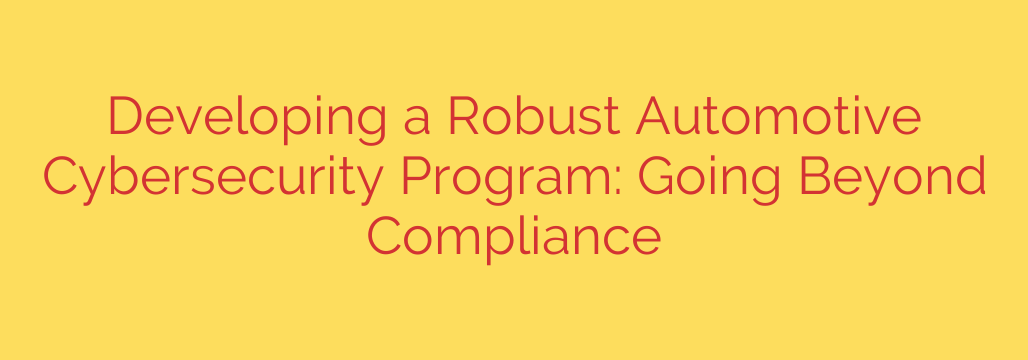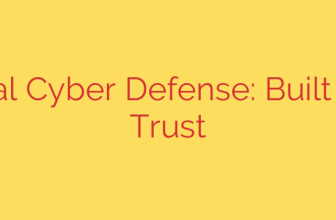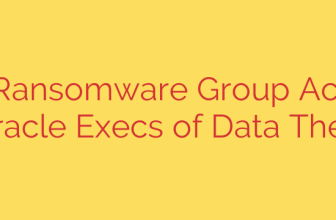
Is Your Automotive Cybersecurity Program Truly Secure? Why Compliance Isn’t Enough
Today’s vehicles are more than just a means of transportation; they are sophisticated, rolling data centers. With hundreds of electronic control units (ECUs), constant connectivity, and the ability to receive over-the-air (OTA) updates, the modern car presents an ever-expanding attack surface for cyber threats. As this complexity grows, the question for automakers and suppliers shifts from if a security incident will happen to how they can build a resilient defense against it.
While landmark regulations like UN R155 and standards such as ISO/SAE 21434 have rightfully pushed cybersecurity to the forefront, simply checking a compliance box is a dangerous and shortsighted strategy. These regulations establish a critical foundation, but they represent the starting line, not the finish line. A truly robust automotive cybersecurity program goes beyond compliance to adopt a proactive, risk-driven mindset that anticipates and mitigates threats throughout the entire vehicle lifecycle.
The Compliance Trap: The Floor, Not the Ceiling
Achieving compliance with regulations is a major undertaking that requires significant resources. It forces organizations to establish a Cybersecurity Management System (CSMS), conduct threat assessments, and implement security controls. However, relying solely on this framework creates a false sense of security for several key reasons:
- Threats Evolve Faster Than Regulations: The regulatory landscape moves slowly, while threat actors innovate constantly. A defense built only to meet today’s rules will be vulnerable to tomorrow’s attack methods.
- Compliance is a Snapshot in Time: A compliance audit certifies that specific requirements were met at a particular moment. It doesn’t guarantee ongoing security in a dynamic environment where new vulnerabilities are discovered daily.
- It Encourages a Reactive Posture: A compliance-first approach often leads to a “check-the-box” mentality. Security becomes a hurdle to clear rather than an integral part of the engineering and corporate culture.
Compliance establishes a baseline for security, but it does not guarantee protection against sophisticated or emerging threats. To build a truly secure system, organizations must treat these regulations as the bare minimum and aim for a much higher standard.
Pillars of a Proactive, Risk-Driven Cybersecurity Program
Moving beyond compliance means shifting from a defensive posture to a state of cyber resilience. This involves embedding security into the DNA of your organization and products. Here are the essential pillars of a modern, effective automotive cybersecurity strategy.
1. Adopt a ‘Security by Design’ Philosophy
The most effective way to secure a vehicle is to build security in from the very beginning. This “Shift Left” approach integrates cybersecurity considerations into the earliest stages of concept and design, rather than trying to bolt them on before production.
- Key Action: Engineers and security experts must collaborate from day one. True security is not a feature added at the end; it is a foundational principle woven into every stage of the vehicle lifecycle. This includes everything from secure coding practices and hardware selection to architecture design that isolates critical systems.
2. Implement Continuous Threat Analysis and Risk Assessment (TARA)
A one-time risk assessment for a compliance audit is not enough. The threat landscape is in constant flux. A robust program involves an ongoing TARA process that continuously identifies new threats, analyzes potential attack paths, and evaluates the risk to vehicle systems and, most importantly, to driver safety.
- Key Action: Establish a living TARA model that is updated with new intelligence on vulnerabilities and attacker tactics. This allows you to prioritize security efforts on the most critical risks rather than just the ones listed in a regulation.
3. Establish Proactive Vulnerability Management and Monitoring
Your responsibility doesn’t end when a vehicle is sold. In fact, the operational phase is where many risks emerge. A comprehensive program must include a plan for monitoring the fleet, detecting threats, and managing vulnerabilities post-production.
- Key Action: Implement a Vehicle Security Operations Center (VSOC) for continuous monitoring of fleet-wide security events. Develop a clear, efficient process for developing and deploying over-the-air (OTA) security patches as soon as vulnerabilities are discovered.
4. Secure the Entire Automotive Supply Chain
A vehicle is an assembly of thousands of parts from hundreds of different suppliers. A security flaw in a single third-party component—whether a sensor, an infotainment chip, or a piece of open-source software—can compromise the entire vehicle.
- Key Action: Mandate and verify stringent cybersecurity requirements for all suppliers. This includes demanding transparency through a Software Bill of Materials (SBOM) and ensuring that your partners adhere to the same high security standards you do. Your vehicle is only as secure as its weakest link.
5. Prepare a Comprehensive Incident Response Plan
Despite the best defenses, a breach is always possible. A well-rehearsed incident response plan is crucial for minimizing damage, ensuring driver safety, and maintaining customer trust. This plan must go beyond IT to include engineering, legal, communications, and executive leadership.
- Key Action: Regularly conduct simulation drills and tabletop exercises to test your incident response plan. Ensure everyone knows their role in containing a threat, recovering systems, and communicating with customers and regulators.
Moving Forward: From Required to Inspired
The future of the automotive industry depends on consumer trust. Drivers must have confidence that the vehicles they rely on are safe not just from physical harm, but from digital threats as well.
To achieve this, automakers and suppliers must evolve their thinking. Cybersecurity cannot be viewed as a cost center or a regulatory burden. It must be seen as a core enabler of innovation and a non-negotiable component of product quality. By moving beyond the reactive, compliance-driven mindset and embracing a proactive, risk-based strategy, you can build a cybersecurity program that not only meets regulations but also delivers true resilience for the long road ahead.
Source: https://www.helpnetsecurity.com/2025/10/02/robert-sullivan-agero-automotive-cybersecurity-strategies/








